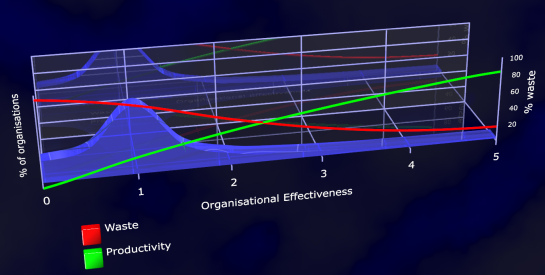Productivity
Productivity
For all the angst and discussion around how to make organisations, teams and people more productive, we might be forgiven for thinking that the idea of “productivity” was commonly understood and agreed.
However, this is not so.
For example, classical economics has a markedly different definition than does Theory of Constraints (TOC). And if you ask someone – in particular managers demanding “higher productivity” – for an operational definition, you may get a blank look, or other definitions again.
“An operational definition is a procedure agreed upon for translation of a concept into measurement of some kind.”
~ W. Edwards Deming
I’m not arguing for one, common, consistent, clear definition. Rather, I’m drawing attention to the confusion over the term – confusion compounded by many folks taking it for granted that they’re all talking about the same things, that they’re all using the same definitions.
“There is no true value of any characteristic, state, or condition that is defined in terms of measurement or observation. Change of procedure for measurement (change of operational definition) or observation produces a new number.”
~ W. Edwards Deming
Here are just some (differing) definitions I found on the Web:
- Productivity = Value / Time
- Productivity is a ratio of production output to what is required to produce it (inputs)
- Productivity = average output per period / total costs incurred or resources (capital, energy, material, personnel) consumed in that period
- The amount of output per unit of input (labor, equipment, and capital).
- The amount of work done, related to the time, effort, money, and energy that was needed to produce it.
- Productivity = Throughput / Operating Expenses
- Productivity = Delivery Rate
So, what is productivity? I’m confused now. Are you?
My Own Definition
When I’m talking about productivity, for example in my presentations and workshops on organisational effectiveness and Rightshifting, I have a particular definition clearly in mind:
“Productivity is the act of bringing a company closer to its goal”
~ Jonah, in The Goal by Eliyahu M Goldratt
Personally, although fully agreeing with Goldratt on this definition, I find it’s hard to use in an explanation or discussion, especially with folks unfamiliar with Goldratt’s work. As the Jonah character goes on to say:
“Productivity is a meaningless concept unless the folks in an organisation understand what their goal is.”
And the book (The Goal) takes a whole book to explain how to discover the Goal in any given organisation.
Aside: This definition of productivity makes it closely congruent with “organisational effectiveness”. See this chart:
So for the purposes of discussion, I sometimes use another definition, derived from the TOC formula:
Productivity = Throughput / Operating Expenses
where:
Throughput = Sales – Totally Variable Costs
(a.k.a. the rate at which the system generates money through sales).
and
Operating Expenses = all the money the [organisation] spends in order to turn inventory into throughput.
So, my simpler definition is:
Productivity is how much it costs an organisation to move one unit (measurable step) closer to its goal (whatever its goal may be – for example, getting a particular product to market).
Note: “Cost” here, and below, is in the most general of terms, maybe a composite function of the Five Capitals, and not necessarily just in financial terms e.g. money or cash.
Or, as an (almost) operational definition, where the goal is (improving) organisational effectiveness:
Cost to move the organisation one unit (say, 0.1 of a rightshifting index point) to the right on the effectiveness axis of the Rightshifting chart.
Note: This is much the same as the Rightshifting measure named “Drag”.
Productivity is a Property of the System
By which I mean, that productivity is never a property of an individual or team, but of the whole system of work within which individuals and teams do their work. This is often referred-to as Deming’s 95% rule.
Productivity in Knowledge Work
Taiichi Ohno said “People don’t go to Toyota to ‘work’ they go there to ‘think’”.
If we take this at face value, then The Goal of Toyota, at least from Ohno’s point of view, was to get its people to ‘think’ (which I take to mean, study the system – the way the work works – and improve it).
Make it Clear
So next time, and every time, the topic – or issue – of productivity comes up, think “Are we all on the same page about what this word actually means?”
Some discussion, to ensure everyone is talking about the same thing, pays major dividends. And, yes, increases productivity.
– Bob
Postscript
Since I first wrote this post, it occurs to me that some readers may infer that I believe productivity is an “unalloyed good thing”. Inasmuch as productivity meets the needs of some folks in an organisation, we might choose to accept this at face value. Personally, I reject worshiping at the altar of productivity, and chooser rather to appreciate that a blind pursuit of productivity at the expense of folks’ wider needs can do much more harm than good.
Post-Postscript
In December 2019 I wrote a post titled “Your Real Job” to highlight just how irrelevant productivity is in most organisations. You might like to take a look.
Further Reading
Cost Accounting is Productivity’s Public Enemy Number One – Abonar’s Blog
Theory of Constraints: Bottom Line Measurements – TOC Guide



Looks like a seed for a great discussion. Couple of quick thoughts as my feedback:
– The idea of “productivity” is closely related to the desire to measure, and in our current culture measuring immediatelly implies some form of numerical, objective metric. This is great if your “goal” is churning out gummy bears – you can then measure a number of things, and those metrics will be meaningful for your context. However, with knowledge work it gets more complex. Of course, in a business, the final measure is money – but usually it doesn’t translate well down to parts of a complex product. In other words: while it is easy to assess the overall economic health of a company, it is hard to attach valid economic value expressed in monetary terms to contribution of each knowledge worker, especially over short periods of time. That makes money useless as a productivity measure on a team level when working on a larger/more complex product.
– your definition’s weak point is that a company’s goal may be changing – a moving target (see also http://bit.ly/ACVZSG ). So while in pricinple you are right I’m not sure how we could use “getting closer to the goal” as a measure of productivity.
– how about productivity for organizations dealing purely with knowledge – like consulting/training companies or universities. I’m curious what you would use as a “unit (measurable step)” there?
Very nice write-up. The “differing” definitions you found on the Web strike me as very similar; possibly re-phrasings of the same definition. That definition is the one that focuses on quantity of output with no reference to goals, value, or the market’s capacity to consume the product. It’s the general sense of the word that I usually assume when the subject is discussed.
I like the other points you raise. Although, as Andy mentions, an organization’s goal may be a moving target, at any given time I think it’s advisable to have an idea of what you’re aiming at before charging off to increase “productivity.”
The tie-in with ToC is interesting as well, in that a single-minded focus on raising a team’s productivity can easily result in a local optimum that generates excessive inventory. To desire productivity (in that sense of the word) for its own sake is a machine’s value, not a human value (a rant I’ve expressed elsewhere http://wp.me/p1CUP0-2V).
Yes good starter for a useful discussion on a difficult concept to pin down – it seems to depend so much on various perspectives. In the tertiary education world one “measure” of productivity that’s often promoted and yet is controversial is the teacher:student ratio.
I’m glad you took on my suggestion to ask for feedback… I’m afraid that creates a debt of giving feedback on my part:-)
I’m glad that this feeling makes me read all your posts, and more thoroughly, so I’m willing to try. I’m in.
I love your amplification of Productivity. Goldratt, Deming, and your definition help understanding what it means—and the reference to productivity being a systemic rather than individual attribute is important.
I’d like to know more about the discernment (especially as a non-native speaker) of productivity, effectiveness, and efficacy.
I love Ohno’s suggestion of coming to work to think. Do you know if (and how) Toyota measures this “thinking”?
Thank you for an inspiring post!
Toyota’s advantage is that they have a tangible, physical product. So they can have all kinds of useful metrics, like for example number of products that are defective, production rate, production cost per units (divided into materials, labor and other costs) etc. It is not so simple for knowledge work. For example what we now do @CodeSprinters primarily is consulting, coaching and teaching. How to measure productivity here? I refuse to measure it solely based on revenues – that would lead us down the path to being a cheap provider of low-quality off-the-mill courses. A better measure would be how useful what we do is for our clients/students, however this is purely subjective and hard to convert into a metric.
One more piece of feedback (sorry for spamming your comment box 🙂 ): Jeff Sutherland (one of Scrum co-creators) is known for his repeated descriptions of “hyperproductive teams”, that – thanks to Scrum of course – outperform traditional teams by 400% in terms of productivity. I think it would be very interesting to learn what measure he uses. He has just published a paper about this – while it doesn’t outright provide his definition of productivity it is, nevertheless, interesting.
http://scrum.jeffsutherland.com/2010/10/scrum-metrics-for-hyperproductive-teams.html
Hi Andy,
Thanks for the link. Some interesting snippets in the referenced paper. Upon reading, I felt cheated because I was hoping for some “good science” and found what looks to me much more like a piece of marketing copy. I was unable to winnow out a useful definition of “productivity” from the hype-chaff.
– Bob
I didn’t promise this paper contains a usuable definition. As I said, it would be very interesting to know what he actually means by saying that hyperproductive teams have 400% better productivity. 400% – but of what?
Reblogged this on Software & Hardware for Geeks.
Pingback: Simples | Think Different